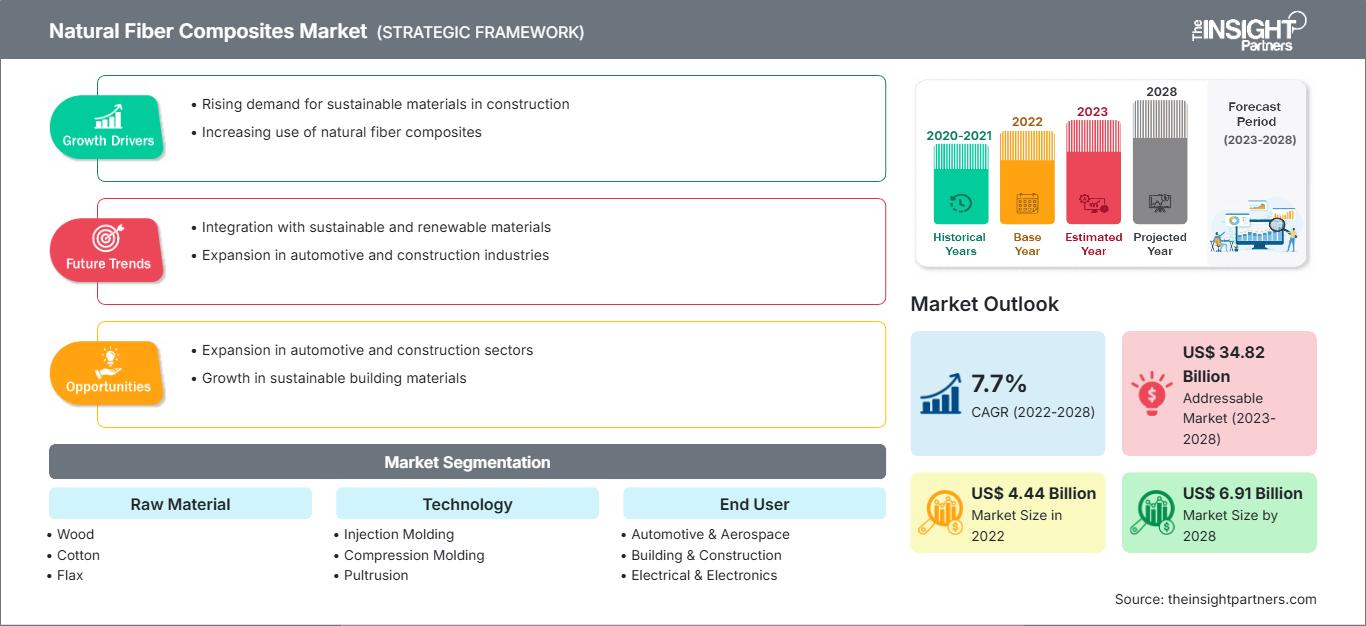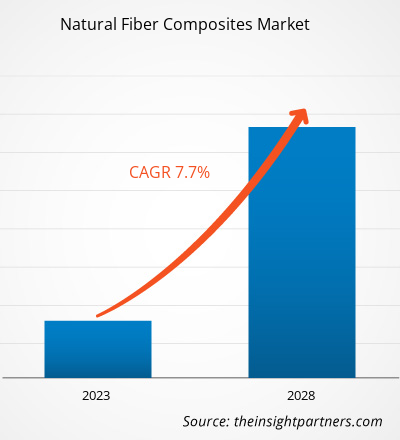The natural fiber composites market is expected to grow from US$ 4,438.83 million in 2022 to US$ 6,910.46 million by 2028; it is estimated to register a CAGR of 7.7% from 2022 to 2028.
Natural fiber composites are composite materials with a polymer matrix embedded with high-strength natural fibers. Natural fibers are used as a component of composite materials, where the orientation of fibers impacts the properties. In composite materials, natural fibers often refer to plant fibers extracted from lignocellulosic biomass such as wood fibers and other plant fibers from the stem, leaf, fruit, and seed.
The demand for fiber-reinforced (glass and carbon fibers) composites is relatively high. However, they are expensive and are not environmentally friendly. These fibers are nonrenewable and nonrecyclable. Many European Union and Asian countries have introduced regulations for the automotive industry. According to European Union legislation passed in 2006, 80% of vehicles should be reused or recycled; in the 2015 revision, this percentage rose to 85%. According to a 2015 regulation in Japan, 95% of vehicles should be reused or recycled. Moreover, drawbacks such as high fiber density, poor recyclability, and handling hazards limit the use of glass fiber composites. These drawbacks of glass fiber composites boost the demand for natural fiber composites.
The natural fiber composites market is segmented into five major regions—North America, Europe, Asia Pacific, the Middle East & Africa, and South & Central America. In 2022, Europe held the largest market share, and Asia Pacific is estimated to register the highest CAGR during the forecast period. High demand for natural fiber composites from the automotive and construction industries favors the growth of the European natural fiber composites market. Further, Asia Pacific, the most populated region in the world, hosts one of the world's most rapidly developing construction and automotive industries. This factor contributes to the high demand for natural fiber composites in the region.
Customize This Report To Suit Your Requirement
You will get customization on any report - free of charge - including parts of this report, or country-level analysis, Excel Data pack, as well as avail great offers and discounts for start-ups & universities
Natural Fiber Composites Market: Strategic Insights

- Get Top Key Market Trends of this report.This FREE sample will include data analysis, ranging from market trends to estimates and forecasts.
You will get customization on any report - free of charge - including parts of this report, or country-level analysis, Excel Data pack, as well as avail great offers and discounts for start-ups & universities
Natural Fiber Composites Market: Strategic Insights

- Get Top Key Market Trends of this report.This FREE sample will include data analysis, ranging from market trends to estimates and forecasts.
Impact of COVID-19 Pandemic on Natural Fiber Composites Market
Before the COVID-19 pandemic, the natural fiber composites market was mainly driven by industries such as automotive, building & construction, sporting goods, and marine. In 2020, various industries had to slow down their operations due to disruptions in supply chains caused by the shutdown of national and international borders. The pandemic hampered manufacturing processes due to restrictions imposed by government authorities in various countries. Natural fiber reinforced composites have major applications in the aerospace and automobile industries, wherein they are used to manage the body weight of vehicles and fuel management. It is used in cement paste and mortar in the construction sector. Hence, with the reduction in activity in these sectors, the demand for natural fiber composites also decreased. The pandemic also caused fluctuations in the prices of raw materials. All these factors led to a decrease in demand for natural fiber composites.
However, in 2021, the economies started reviving as various industries resumed business activities. As a result, several industries, including automotive and building & construction, showed signs of recovery in their operations. Various industries are also overcoming the consequences of disruptions in their raw material supply chains. With such a promising recovery, the global industrial sector is expected to provide the impetus for the natural fiber composites market growth in the coming years.
Market Insights
Strategic Developments by Key Players Favor Natural Fiber Composites Market Growth
In July 2022, BMW Group, the premium carmaker's venture capital firm, invested in a Swiss clean tech company Bcomp Ltd, a manufacturer of high-performance components made from natural fibers. Such strategic developments by key players are expected to bolster the natural fiber composites market growth in the coming years. In addition, key market players are involved in strategies such as mergers and acquisitions to expand their geographic presence.
Raw Material-Based Insights
Based on raw material, the natural fiber composites market is segmented into the wood, cotton, flax, kenaf, hemp, and others. The hemp segment is expected to register the highest CAGR during the forecast period. Hemp fibers are found in the stem of the plant, making them strong. They are essential for the fortification of composite materials. With the surging demand for sustainable, biodegradable, and recyclable materials, the use of hemp fibers as support in composite materials has increased. Natural fiber composites made from hemp are biodegradable.
End User-Based Insights
Based on end user, the natural fiber composites market is divided into automotive & aerospace, building & construction, electrical & electronics, sporting goods, and others. The automotive & aerospace segment dominated the market in 2022. Natural fiber composites are widely used in fabricating electric car components because of their lightweight qualities. Due to their better stiffness and strength compared to other synthetic fibers and better acoustic insulation properties, these composites are also employed in vehicle door panels, seat backs, floor panels, underfloor pans, and trunk liners.
UPM-Kymmene Corp, Flexform Technologies LLC, Polyvlies Franz Beyer GmbH, Amorim Cork Composites SA, Tecnaro GmbH, Lanxess AG, Bcomp Ltd, Cobra Advanced Composites Co Ltd, Plasthill Oy Ltd, and Lingrove Inc are among the major players operating in the natural fiber composites market. These companies mainly focus on product innovation to expand their market share and follow emerging market trends.
Natural Fiber Composites Market Regional Insights
The regional trends and factors influencing the Natural Fiber Composites Market throughout the forecast period have been thoroughly explained by the analysts at The Insight Partners. This section also discusses Natural Fiber Composites Market segments and geography across North America, Europe, Asia Pacific, Middle East and Africa, and South and Central America.
Natural Fiber Composites Market Report Scope
| Report Attribute | Details |
|---|---|
| Market size in 2022 | US$ 4.44 Billion |
| Market Size by 2028 | US$ 6.91 Billion |
| Global CAGR (2022 - 2028) | 7.7% |
| Historical Data | 2020-2021 |
| Forecast period | 2023-2028 |
| Segments Covered |
By Raw Material
|
| Regions and Countries Covered | North America
|
| Market leaders and key company profiles |
|
Natural Fiber Composites Market Players Density: Understanding Its Impact on Business Dynamics
The Natural Fiber Composites Market is growing rapidly, driven by increasing end-user demand due to factors such as evolving consumer preferences, technological advancements, and greater awareness of the product's benefits. As demand rises, businesses are expanding their offerings, innovating to meet consumer needs, and capitalizing on emerging trends, which further fuels market growth.

- Get the Natural Fiber Composites Market top key players overview
Report Spotlights
- Progressive industry trends in the natural fiber composites market to help companies develop effective long-term strategies
- Business growth strategies adopted by market players in developed and developing countries
- Quantitative analysis of the natural fiber composites market from 2020 to 2028
- Estimation of global demand for natural fiber composites
- Porter's Five Forces analysis to illustrate the efficacy of buyers and suppliers operating in the natural fiber composites industry
- Recent developments to understand the competitive market scenario
- Market trends and outlook, as well as factors driving and restraining the growth of the natural fiber composites market
- Assistance in the decision-making process by highlighting market strategies that underpin commercial interest
- Size of the natural fiber composites market at various nodes
- Detailed overview and segmentation of the market and growth dynamics of the natural fiber composites industry
- Size of the natural fiber composites market in various regions with promising growth opportunities
Frequently Asked Questions
What is the key driver for the growth of the global natural fiber composites market?
In 2022, which end-user segment accounted for the largest share in the natural fiber composites market?
Which technology segment is expected to account for the fastest growth in the global natural fiber composites market?
In 2022, which raw material segment accounted for the largest share in the natural fiber composites market?
Can you list some of the major players operating in the global natural fiber composites market?
In 2022, which region held the largest share of the global natural fiber composites market?
- Historical Analysis (2 Years), Base Year, Forecast (7 Years) with CAGR
- PEST and SWOT Analysis
- Market Size Value / Volume - Global, Regional, Country
- Industry and Competitive Landscape
- Excel Dataset
Recent Reports
Related Reports
Testimonials
Reason to Buy
- Informed Decision-Making
- Understanding Market Dynamics
- Competitive Analysis
- Identifying Emerging Markets
- Customer Insights
- Market Forecasts
- Risk Mitigation
- Boosting Operational Efficiency
- Strategic Planning
- Investment Justification
- Tracking Industry Innovations
- Aligning with Regulatory Trends





















 Get Free Sample For
Get Free Sample For